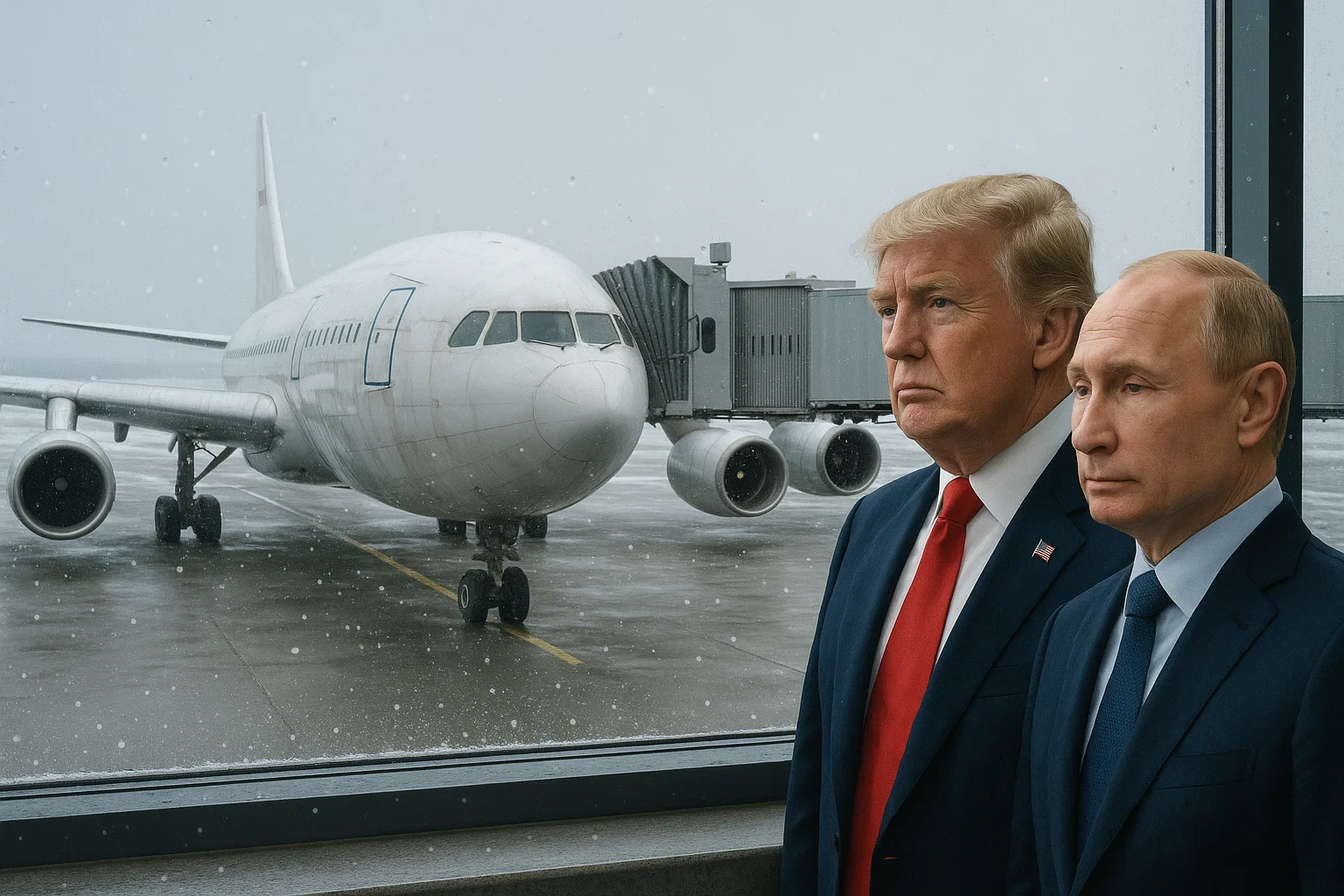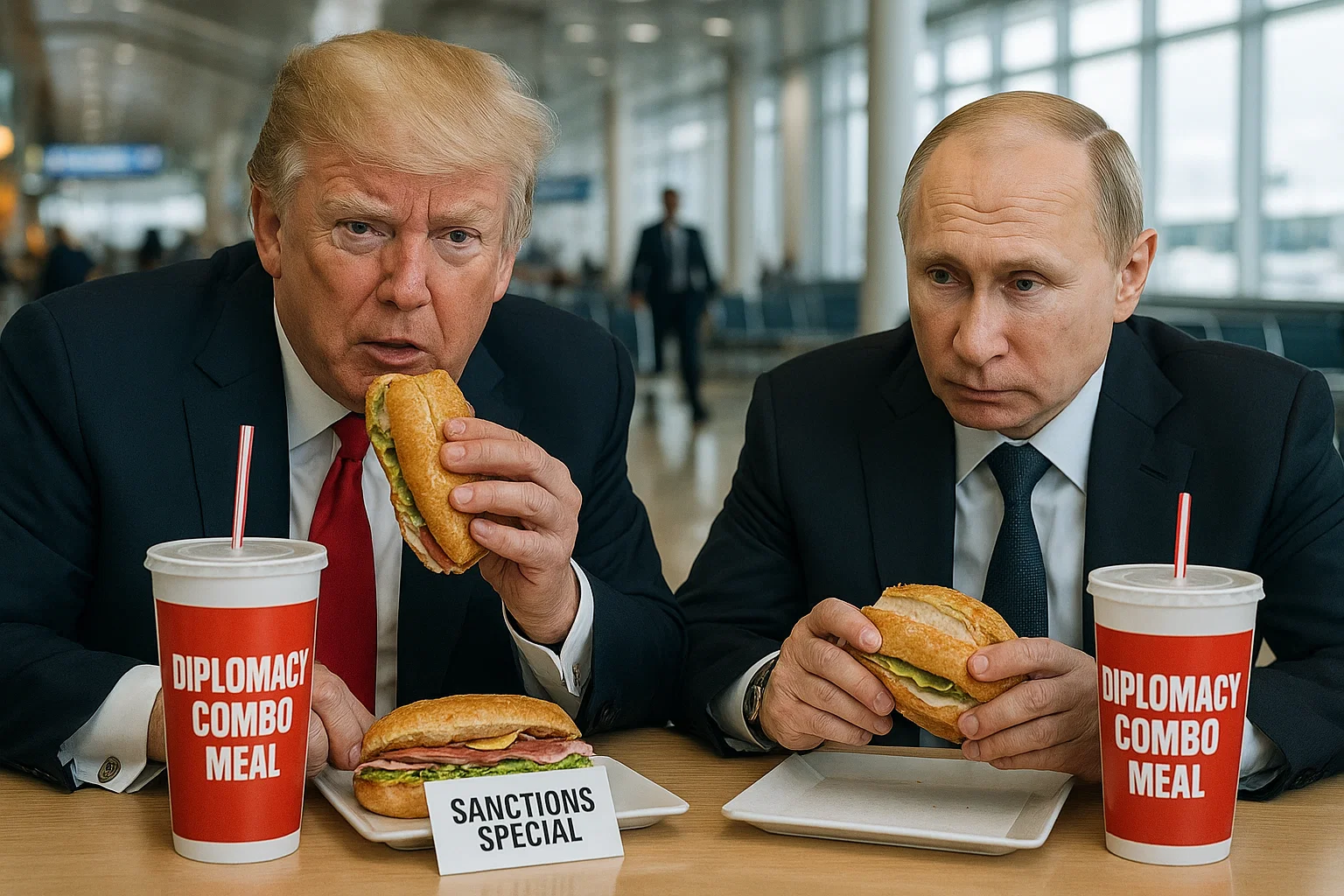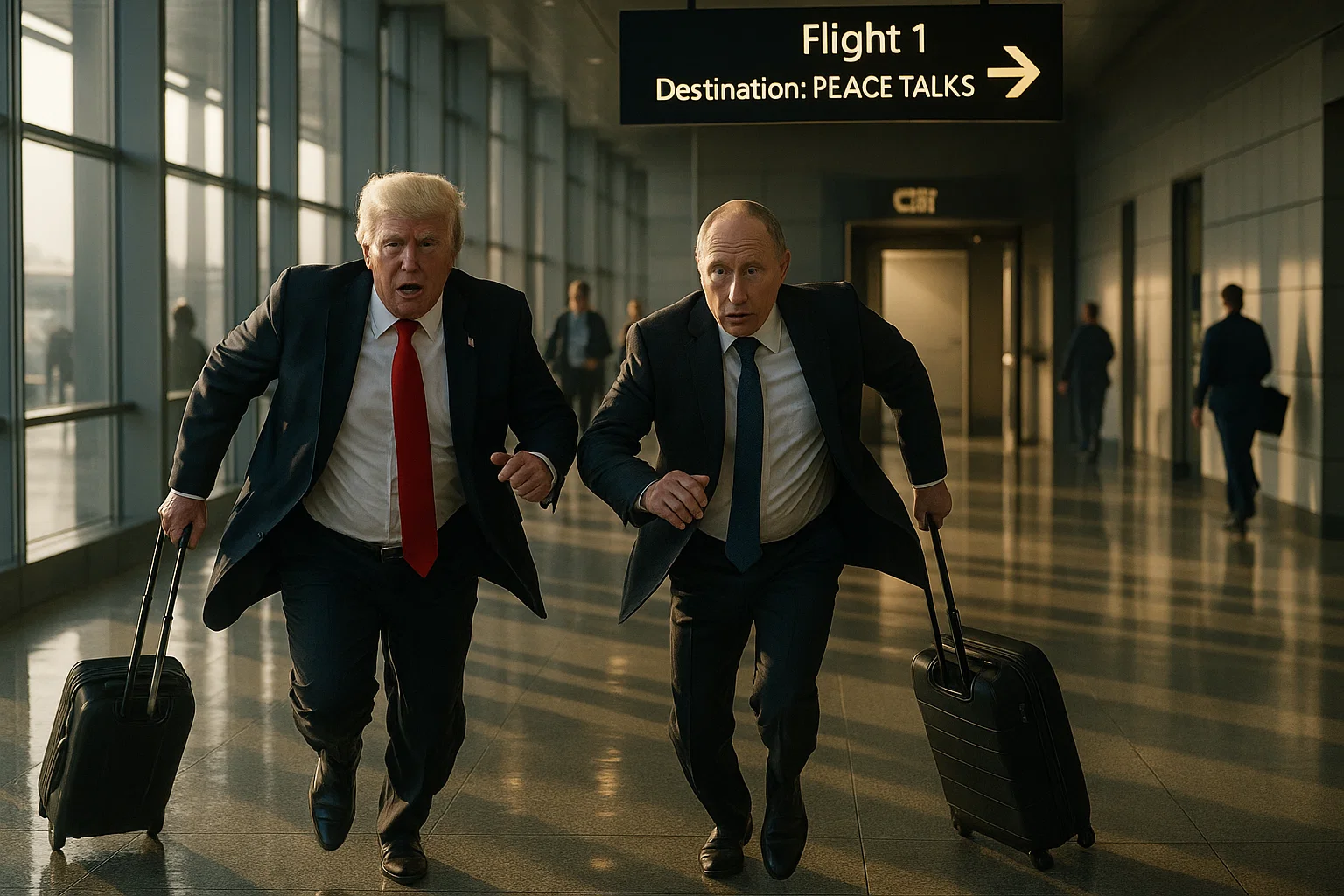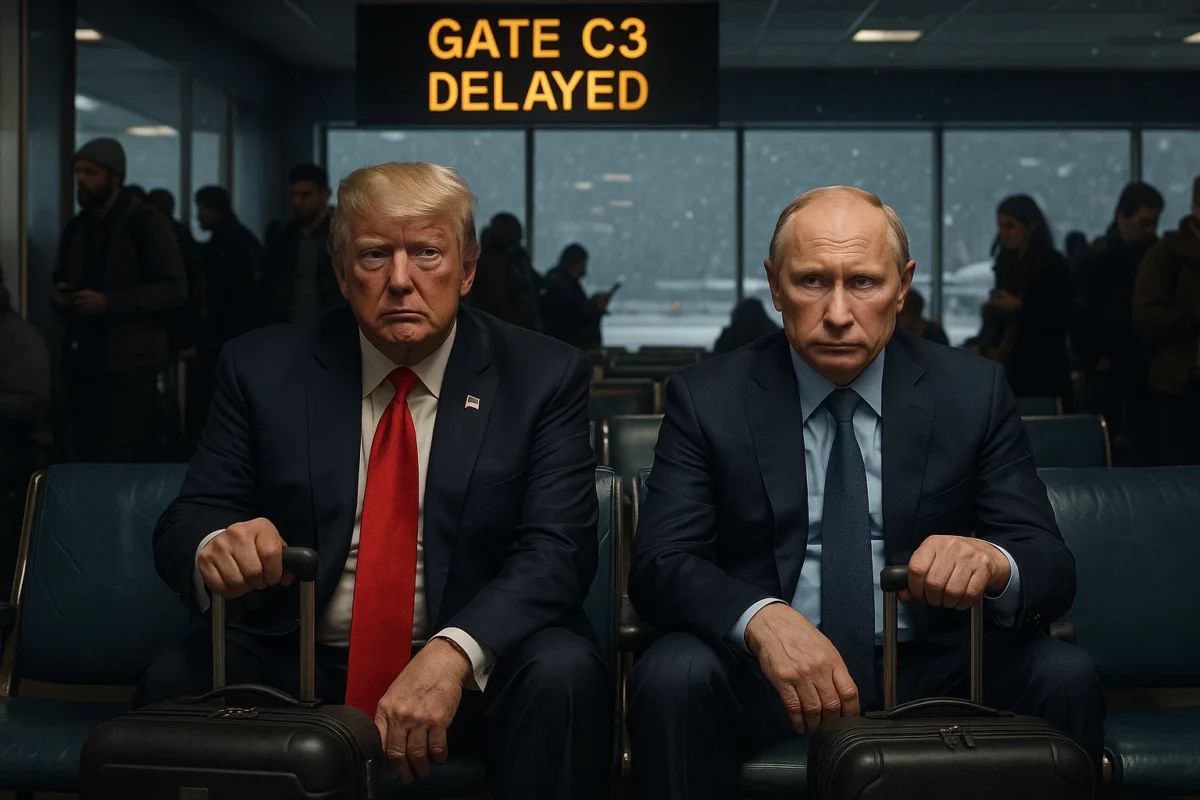ANCHORAGE, AK — Somewhere between a Hudson News and a suspiciously optimistic departures board, two heads of state discovered the most humbling force in geopolitics: airport time. The meeting billed as a high-stakes summit became, in practice, an extremely tense layover punctuated by announcements about pre-boarding for families with small children and anyone needing extra time, which, to be fair, included most of the planet. For the record, officials say the session is set for 11 a.m. AKDT at Joint Base Elmendorf–Richardson, a brisk ride from Ted Stevens Anchorage International, where existential questions about war and peace must compete with existential questions about whether the café will honor mobile orders.
Welcome to Anchorage International Diplomacy

Anchorage wasn’t chosen by spinning a globe and stabbing it with a cocktail sword, though it feels like it. The backdrop is a legit military-meets-civilian mashup: a summit hosted at Joint Base Elmendorf–Richardson, with all roads leading through the fluorescent glare of the concourse. The fact sheet reads like a frequent flyer’s fever dream: meet at the base, pace at the terminal, and, time permitting, ponder whether the $32 salmon jerky bundle is a cultural exchange or a cry for help.
Every detail feels weaponized for comedy, starting with the schedule: a tidy 11 a.m. kickoff that in airport hours translates to “whenever they find a working outlet.” Local coverage gamely assures us that Anchorage is both a practical midpoint and a historical stage for far-flung diplomacy, a claim sturdily supported by the city’s epic tradition of turning every weather event into an unofficial national holiday. If you’re searching for clues, the locals already tried: the venue speculation tour ran through every hangar and hangout in a 10-mile radius. Either way, the airport kiosk selling “Moose You Were Here” magnets is about to experience a foreign policy surge.
Gate C3: Now Boarding Ego and Luggage

The star of our opening act is not a person but a plane: Russia’s widebody Il-96, a hulking Cold War vibe machine that somehow looks both regal and chronically undercaffeinated. Spotters and reporters tracked the approach and arrival into Anchorage like it was the season finale of a prestige drama, because it is. Aviation outlets even logged multiple Russian support aircraft tied to the trip, because nothing says “We brought talking points” like bringing an entire airborne filing cabinet. For the airplane porn, please direct your attention to the helpful visual aids at AeroTime, which treats the itinerary like a rare bird sighting with geopolitics attached.
Once the jet bridge kisses aluminum, the political theater collapses into airport slapstick. Who boards first: heads of state or a random band of “Group 1” customers who somehow achieved Diamond Platinum Titanium Ultra Status by filling out a form in 2013? The live blogs are primed for every ankle-level development, see The Guardian’s rolling updates, while the local beat maps the motorcade geometry like a puzzle box. If anyone asks why global power brokers are stretching beside Gate C3 like a rec league, just tell them: it’s the altitude, the attitude, and the sudden realization that even superpowers are powerless against a delayed catering truck.
Airport Cuisine: Sanctions in Sandwich Form

Negotiations require leverage; airports require calories. The Venn diagram is a circular pretzel with mustard. Here, tariff schedules become menu boards and “targeted relief” is a limited-time combo. Will economic pressure loosen if someone discovers the restorative power of a $19 tuna wrap? Analysts ask serious questions, like whether Moscow intends to dangle energy deals or policy concessions, and outlets such as Al Jazeera dutifully examine how this could play out on paper. On cafeteria trays, however, the math is simpler: trade a basket of crinkle fries for a corridor of humanitarian access and call it a pilot program.
Meanwhile, the broader stakes jog along in the background like a traveler power-walking through the terminal. The Wall Street Journal sketches clashing objectives; Reuters’ live file catalogs the day’s micro-dramas and macro-ambiguities. The practical translation is culinary: everything is “market price,” and the market appears to be Big Mood plus Big Salmon. If the talks yield a breakthrough, it will probably be because someone finally discovered that when you put “Detente” on a menu board, people think it’s an artisanal mustard and simply say yes.
TSA: The True Summit

Diplomacy has protocols; TSA has bins. Somewhere between the magnetometer and the collective sigh, mutual mistrust becomes a set piece. “Declare all liquids over 100 milliliters” doubles as a metaphor for “declare all non-starters.” The security ritual is universalizing; even motorcades pause before the conveyor belt. The stakes, however, are less metaphorical for the bean counters. Just getting everyone here legally requires rule-bending that only a government can love. The day’s schedule and cast are tracked in outlets like Reuters and AP, while the actual compliance plot twist is buried in the fine print of Washington: a short-fuse general license that lets otherwise restricted logistical bits happen without triggering a fire alarm.
Yes, that’s a thing you can read with your own eyeballs: an OFAC document that turns sanctions into a black-and-white scavenger hunt. It’s the bureaucratic equivalent of TSA PreCheck, except instead of taking your shoes off faster, you get to land an Il-96 in Alaska without violating the vibes code. It’s not détente; it’s Detent-ish. If every summit is a security line, this one is the premium queue sponsored by “Please Don’t Start an International Incident While We’re Counting Bins.”
Duty-Free Détente

Duty-free is where the heavy lifting happens, literally, because glass bottles. What begins as a stroll through the fragrance aisle becomes the allegory we didn’t know we needed: “Would you trade sanctions relief for something that smells like bergamot and plausible deniability?” The daybook again leans on the wire services, see the time-and-place frame and the rolling updates, and on deep dives like the Journal’s explainer about what each side wants to stuff into their carry-on.
The shopgirl energy is palpable: “Can I interest you in a peace accord? It pairs beautifully with this aftershave.” Meanwhile, aides argue over the finer points: carve-outs, corridors, cease-something-or-other. Everyone nods solemnly as if they understand the difference between a framework and a framework-adjacent vibe. If a statement emerges at all, expect it to smell faintly of vanilla and effort. The receipt will be comically long, and the cashier will circle the parts where you can’t return anything after opening.
Final Boarding Call for Peace

At some point every summit runs out of time; at airports they announce this on a PA that sounds like it’s underwater. The choreography is familiar: staffers jog; cameras sprint; one of the leaders detours to wave at a child, thereby becoming a meme; someone reports that the final readout is “forthcoming,” which is diplomatic for “hit refresh until your soul leaves.” Coverage loops through the meta-beats, TV packages, live tickers, and dateline signposts, while the clock grinds toward an invisible gate agent who is absolutely closing that door on cue.
Here is the truth that haunts both diplomacy and travel: even if you make the flight, your baggage may not. Maybe a joint statement materializes; maybe it connects in Seattle without you. But if peace is a trip with many legs, Anchorage is the one where you sprint, spill your coffee, and discover that international affairs, like overhead bins, are always smaller than you remember. If we do depart, we’ll be flying stand-by on hope, cruising altitude TBD, snacks available for purchase.
Final call for satire: while your joint statement taxis to the gate, taxi back to The Takeoff Nap for more layover-level absurdity.
- If today’s summit felt like a security line with extra geopolitics, watch the conveyor belt spin in The TSA Rebrands as the Trump Spectacle Authority.
- For more runway diplomacy and plane-spotting envy, perfect for anyone staring at an Il‑96 through frosty glass, browse Global Leaders Offer Trump Unique Air Force One Replacements.
- And if the PA at Gate C3 sounded suspiciously on-brand, reboard the bit with President-Elect Trump Declares: “All Airlines Are Now American Airlines”.

